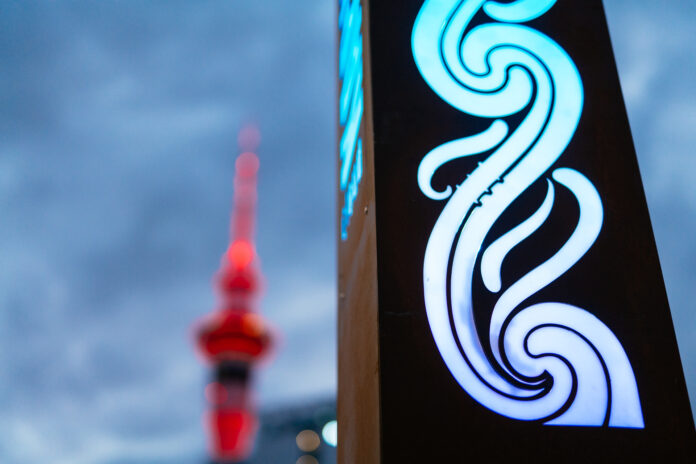Source: Auckland Council
Scan a QR code on the side of two steel pourama (light columns) standing tall on the corner of Sale Street and Wellesley Street and hear a poem by celebrated New Zealand manu kōrero/poet Hone Tuwhare recited in both te reo Māori and english by the children of the young men who have led this project.
Hone Tuwhare (Ngāti Korokoro, Ngāti Tautahi, Te Popoto, Te Uri-O-Hau) remains a national treasure, and stands as one of the most important Māori literary voices of the twentieth century.
Hone lived in Nelson Street as a child, attended Campbell’s Kindergarten nearby in Victoria Park, and worked as a boilermaker in a workshop along Sale Street as a tradesman in the 1970s. His footprints, and now his words through this initiative are again alive and celebrated in this place.
This project has been granted permission by the Tuwhare whānau to utilise one of Hone’s poems The river is an island to highlight the memory of the stream that ran through this site. The poem Hone wrote in English has been translated into te reo Māori by Waihoroi Hotorene (Ngāti Hine) as part of a new placemaking project, Te Maharatanga o Ngā Wai, which illuminates the waters flowing beneath our city.
Te Maharatanga o Ngā Wai.
Remembering our waters.
While many of the natural waterways which once flowed through Auckland’s city centre have been lost from sight – channelled, piped and progressively covered over – a new Māori design kaupapa, developed in an innovative partnership between Ngāti Whatua Ōrākei and Te Kaunihera o Tāmaki Makaurau / Auckland Council, will see those urban waters remembered.
On 10 December at dawn, a new public place on the corner of Sale Street and Wellesley Street was unveiled. People who pass by will discover it carries meaning that is much more than it seems.
The project, enabled by the Auckland Council’s City Centre Targeted Rate and Māori Outcomes funding, is set to bring a unique and thought-provoking public place design to the area.
[embedded content]
The process adopted through this partnership has provided a unique education, mentoring and collaboration platform for two young kaitiaki from Ngāti Whatua Ōrākei and Auckland Council’s Māori Design intern.
The three young men who have delivered this work, alongside the Te Kaunihera project team and under the guidance of Māori landscape architect Alan Titchener (Kai Tahu), are: Jyde Tamaariki (Ngāti Whātua Ōrākei), kaitiaki rakau; Etienne Neho (Ngāti Whātua Ōrākei), kaitiaki rakau; and Kahurangi Eruera (Te Tai Tokerau/Te Tairāwhiti), Te Kaunihera Māori Design intern currently studying his Master of Architecture.
Jyde Tamaariki (Ngāti Whātua Ōrākei), kaitiaki rakau; Etienne Neho (Ngāti Whātua Ōrākei), kaitiaki rakau; and Kahurangi Eruera (Te Tai Tokerau/Te Tairāwhiti), Te Kaunihera Māori Design intern currently studying his Master of Architecture
The initiative is called Te Maharatanga o Ngā Wai, remembering our waters.
Dane Tumahai of Ngāti Whātua Ōrākei says: “As ahikaa and in the spirit of our tupuna Apihai Te Kawau we continue to foster manaakitanga and seek nuture the growth of our rangatahi that sees our cultural identity reflected in the whenua and moana. ‘Kakahuria nga tangata, Kakahuria te Taiao’. Adorn the people so they can adorn the environment.”
Councillor Pippa Coom says Te Kaunihera o Tāmaki Makaurau / Auckland Council sees its main role in this project as empowering others.
“We are seeing inspiring leadership from the young people who are delivering this project. I suspect Te Maharatanga o Ngā Wai will become a benchmark way of working as we seek to bring uniquely Tāmaki Makaurau design to the city,” she says.
Six elements are evident in the design: reo (language), whakatā (rest and relaxation), taiao (natural environment), tūrama (lighting), mahi toi (art) and whakamārama / ako (explanation, teaching and learning).
Phil Wihongi, Māori Design Lead of the Urban Design Unit at Te Kaunihera o Tāmaki Makaurau says: “All of these elements have been designed to remind us of these lost streams, and to prompt us to consider the place of nature and natural systems in the design of our urban environments.”
The work began with the planting of an understory of greenery beneath pōhutukawa. The plants were grown in the Ngāti Whatua Ōrākei nursery, selected by the designers, and brought to the site for planting. Ngāti Whatua Ōrākei kaitiaki will also maintain this planting for all to enjoy.
Four concrete seats were 3D-printed off-site demonstrating the potential of this new technology. Each of the seats contain around 40 repurposed car tyres, minimising the use of concrete and diverting the waste rubber away from landfill.
The curved organic shape of these tūru / benches draws inspiration from the lost stream’s natural form and the life that would have flourished in this place, in particular tuna (eels).
Two laser-cut corten steel pourama (light columns) spill light through the lettering, casting kupu reo (words) onto the pavements with themes of kapua (cloud), ua (rain), awa (river), moana (sea) that describe the natural water cycle, and an overarching message: oranga wai, oranga tāngata (healthy waters, healthy people).
The dawn blessing and official opening on 10 December marked the beginning of a journey of ako / teaching and learning for Aucklanders, with whakamārama / explanation on-site, about the waters that flow beneath our city.



